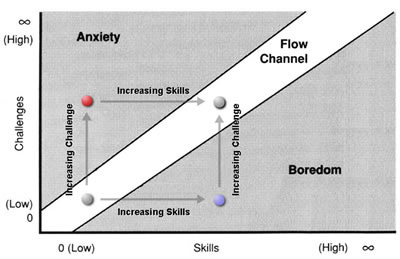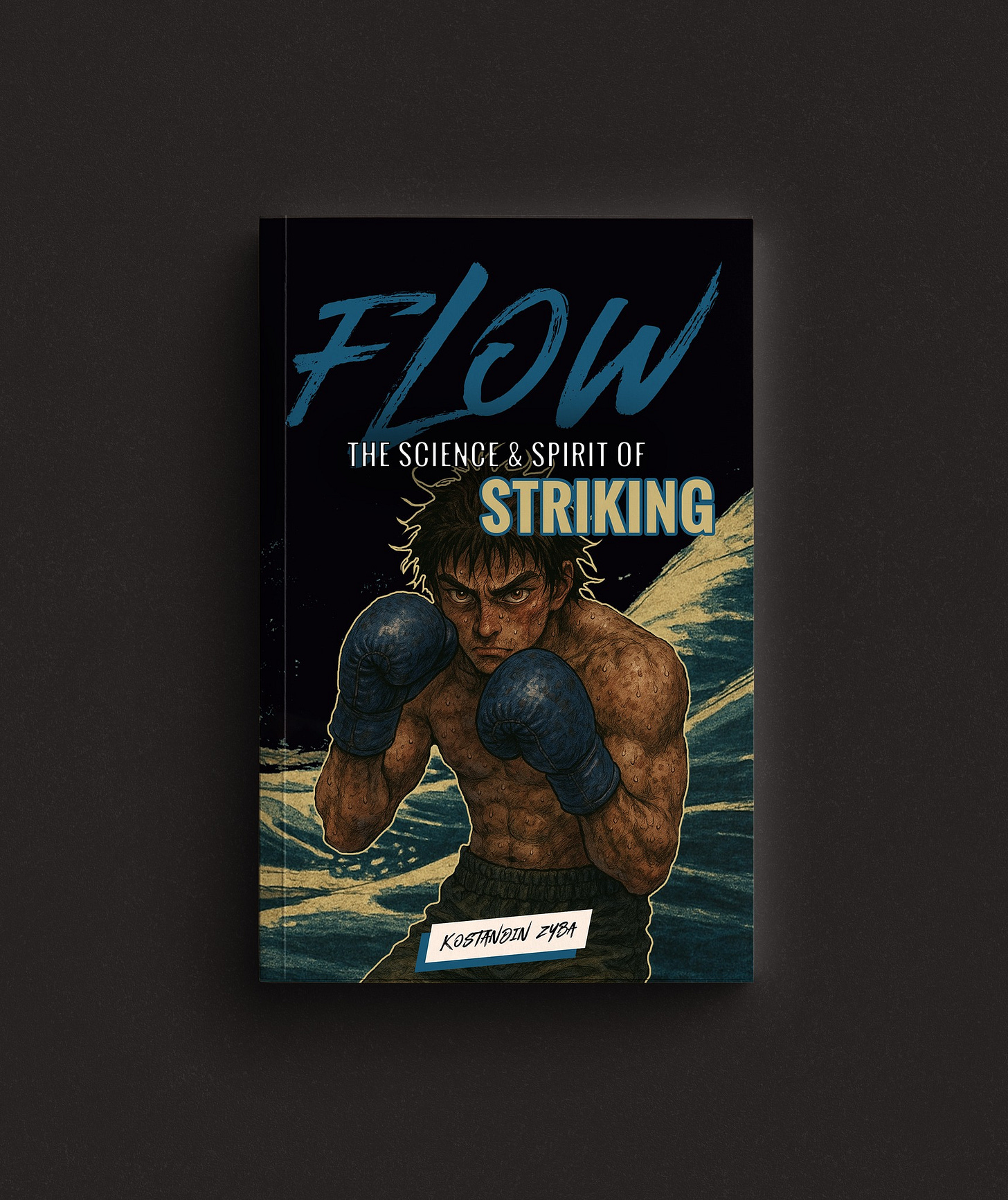Including FLOW STATE in training
The Pen and Sword Journal - Vol 86
Flow is that elusive state when body and spirit fuse, and you just do. Psychologists call it complete absorption. Many associate it with Mushin (“no mind”). While these concepts share similarities, they are not exactly the same. And the main difference is the root cause for each of them. While both states involve deep focus and effortless action, Mushin is more about emptiness of thought, whereas flow is about total engagement in an activity. Some argue that Mushin is a more spiritual or philosophical state, while flow is a psychological one. I will delve deeper into their differences in another article.
Flow state, as described by psychologist Mihaly Csikszentmihalyi, is a mental state of complete immersion in an activity. When in flow, a person experiences effortless focus, a loss of self-consciousness, and a sense of time distortion. It often happens in activities like sports, music, or creative work. It’s that moment when your body, trained and honed through endless repetition, takes over, and you simply react.
If you’ve been there before, you know it: the zone. The flow state. The times when your entire being is so connected to the task at hand that the outside world vanishes. You are one with the fight. Everything falls away. Time distorts. An hour feels like a second, or a split second seems to stretch out endlessly. You don't need to think, and your training does the talking for you. When you’re in this zone, you’re at the peak of your performance, and everything feels like it’s clicking.
What Does Flow Feel Like?
Flow is not just something that happens in sports. It happens in life too, and in martial arts, it's one of the most powerful states you can experience. You know that feeling when you’re sparring, and everything you’ve trained for just flows? Or when you’re practicing a form, and every movement feels like it’s in perfect harmony with the rhythm of the universe? That’s flow.
It’s the sensation of being so completely absorbed in the moment that you lose all sense of time. When flow happens, your mind is clear, and your movements are sharp and instinctive. A fighter once described it as “being in the flow” when punches and kicks come out without hesitation or thought. There's no more second-guessing, no more overthinking. The body simply responds, instinct taking over from the mind.
In flow, you’re not concerned with the outcome of the fight. You’re not thinking about winning or losing. You’re simply immersed in the process, enjoying the rhythm of combat, the sharpness of your technique, and the precision of your movement. It’s a deep focus that transcends everything around you, and in that moment, you’re no longer worried about how you look or what others might think. You’re just there, in the moment, fully present.
The Science of Flow: What’s Happening in Your Brain?
You might wonder, what’s actually happening in your brain when you hit that flow state? It’s more than just an emotional high. In flow, your brain undergoes a profound transformation. The part of your brain responsible for rational thought ( your prefrontal cortex) actually quiets down . This is called hypofrontality. Essentially, the thinking mind takes a backseat, and your instinctive, trained body takes the wheel. The fear center of the brain, the amygdala, is also subdued, which is why you’re able to operate without fear or anxiety holding you back .
In this state, you’re not fighting with your mind to perform. You’re performing naturally, as if your body knows what to do. In fact, flow essentially allows your body’s subconscious neural pathways to dominate. This is the reward for all those endless hours of training. The reflexes, instincts, and movements you’ve repeated so many times during practice are now so ingrained in your body that you don’t have to consciously think about them. They just happen. It’s a state where action and awareness merge, and you perform at your peak .
The Conditions for Flow
So, how do we make flow happen more consistently in martial arts? Flow doesn’t come on command. It’s a delicate balance of factors that need to align, and that can take time and effort to master.
1. Challenge-Skill Balance
Flow happens when the challenge you’re facing aligns perfectly with your skill level. Too easy, and you’ll get bored. Too hard, and you’ll become overwhelmed with anxiety and fear. In martial arts, this means finding that sweet spot where you’re being pushed just beyond your comfort zone, but not to the point of panic. Spar with an opponent who’s slightly better than you, or try a new technique that’s within your reach but still a bit of a stretch. This balance is what allows flow to thrive .
2. Clear Goals and Feedback
To enter flow, you need to know what you’re trying to achieve. This could be as simple as landing a clean jab, maintaining a tight guard, or keeping your rhythm during sprinting, kata, or shadow boxing. Knowing exactly what you’re working toward helps you stay engaged and connected to the task at hand. In sparring, you’re aware of how well you’re doing in the moment, whether you're landing hits, avoiding strikes, or staying in your rhythm. This feedback loop gives you the confidence and clarity to keep pushing forward .
3. Preparation and Consistency
This one is simple:
You can’t flow without the foundation of consistent training.
Flow isn’t something you can force. It’s the result of countless hours spent honing your art, sharpening your techniques, and building your skill. You cannot expect to enter flow without first committing to the long, sometimes grueling, process of becoming proficient in your martial art. Your flow state is built on the sweat, the repetitions, and the mental focus you’ve poured into your practice.
Stop Chasing the Outcome: Surrender to the Moment
One of the hardest lessons to learn in martial arts is to stop overthinking. When you’re sparring, you can’t afford to be STUCK thinking about winning or losing. When you’re performing, you can’t be worried about how you look or what others think. You need to let go of the outcome and focus purely on the process. As a coach told me years ago:
“Surrender to the moment… trust your training, get out of your own way, and let go so a fabulous performance can flow out of you.”
This mindset shift - focusing only on the present moment and trusting your preparation – is key to unlocking flow .
The Flow Formula: Challenge, Preparation, and Connection
You want to experience flow more often? Here's a simple formula that can guide you:
Challenge: Pick an opponent, a drill, or a technique that stretches you without overwhelming you. This is where you feel challenged but capable .
Preparation: Trust that you’ve put in the work. Trust in your training, your body, and your instincts. Preparation creates confidence, and confidence creates flow .
Connection: Connect with the deeper reason why you train. Whether it’s the love for the art, a goal to protect others, or honoring your dojo, find the meaning in your training. This connection adds a layer of intrinsic motivation that fuels your flow .
When these three factors come together - a challenge you’re prepared for, deep connection to your purpose, and trust in your training- flow will happen more naturally. The beauty of flow is that it’s not forced, instead, it comes when you allow it. Surrender to the process, trust in your training, and let your body lead. Flow isn’t a destination, it’s a path, and every time you step onto the mats, you have the opportunity to experience it again. And again.
Don’t worry if you sometimes can’t tap into it as easily as you did the other day. We all have our ups and downs, and this is mostly influenced by certain biorhythms guided by our powerful unconscious forces. Whenever I experience these ups and downs, I like to remind myself of a Zen story:
A student approached his meditation teacher, frustrated. He complained, "My meditation is horrible! I feel distracted, my legs ache, and I keep falling asleep. It's just awful!" The teacher calmly responded, "It will pass."
A week later, the student returned, this time excited. "My meditation is amazing! I feel so aware, peaceful, and alive!" The teacher smiled and said again, "It will pass."
The same is true for you and me. If you find it someday hard to “be in the zone”, don’t be so hard on yourself. It WILL pass. 😊
If you're curious to dive deeper into this topic, I’ve explored it in more detail in my book, titled "FLOW: The Science and Spirit of Striking." It delves into preparing all three components of being in the flow: body, mind, and spirit. It will be a great guide with a proven method on how to cultivate the inner state that will help you unlock your fullest potential in martial arts and in other areas.
Wish you a great start of the week! 🙏 and…
➡️ as always dear friends, if you liked reading this, feel free to click the ❤️ button on this post, so more people can discover it on Substack.
📌 For those who visit for the first time: 𝙏𝙝𝙞𝙨 𝙥𝙖𝙜𝙚 𝙝𝙖𝙨 𝙖 𝙢𝙞𝙨𝙨𝙞𝙤𝙣.
I am dedicating my life to developing practical psychological and philosophical methods to integrate the Way of the Warrior into daily life.
But this cause can achieve more, and for that, I need your support.
Your contribution can help me dedicate more time and resources to conduct research and share more work with those who need to delve deeper into the Way of the Warrior.
If this resonates with you, I invite you to support my cause on Substack by becoming a contributor.
🔻📕Additional Resources:
If you've found my article helpful and inspiring and want to delve deeper into the subjects of psychology, philosophy, the warrior ethos and zen, I recommend checking out my books:
📕➡️100 thoughts for the Inner Warrior
Whether you're seeking personal growth, to fortify your inner strength and mental resilience, or simply a deeper understanding of the warrior ethos, "100 Thoughts for the Inner Warrior" is a valuable resource that can guide you on your journey.
This is my latest book, and it’s packed with proven psychological techniques to help you access your mind’s hidden reserves and build the willpower, tenacity and discipline needed to face any challenge. From strategies to quiet the inner voice of self-doubt to exercises that master the art of delayed gratification, each chapter guides you on a path toward mental, physical and emotional mastery.
👉 Furthermore, you can consider joining my WhatsApp channel via this link if you don’t want to miss future updates.




